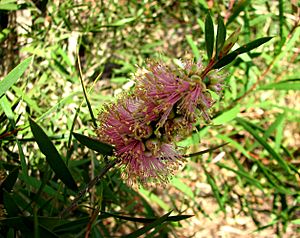Wimmera bottlebrush facts for kids
Quick facts for kids Wimmera bottlebrush |
|
|---|---|
 |
|
| M. wimmerensis in Royal Botanic Gardens, Melbourne | |
| Conservation status | |
| Scientific classification | |
| Genus: |
Melaleuca
|
| Species: |
wimmerensis
|
| Synonyms | |
|
Callistemon wimmerensis Marriott & G.W.Carr |
|
The Wimmera bottlebrush (Melaleuca wimmerensis) is a special plant. It belongs to the myrtle family, called Myrtaceae. This plant is endemic, which means it only grows naturally in one place. For the Wimmera bottlebrush, that place is the state of Victoria in Australia.
This shrub was only discovered recently in 2008! It often has many stems growing from a special woody base called a lignotuber. The Wimmera bottlebrush looks a lot like the River bottlebrush (Melaleuca paludicola). However, its flowers are pink or purple with yellow tips. They bloom for a short time between October and early December.
Contents
What the Wimmera Bottlebrush Looks Like
The Wimmera bottlebrush is a shrub that can grow up to about 10 meters (33 feet) tall. It often has many stems and a thick top part, like a crown. Its bark is grey to brown and feels like fiber.
Leaves
The leaves of this plant grow in an alternating pattern along the stem. They are usually between 30 and 50 millimeters (1.2 to 2 inches) long. The leaves are narrow and shaped like an egg, tapering to a sharp point. You can see a main vein in the middle of the leaf. Tiny oil glands are visible on the underside of the leaves.
Flowers and Fruit
The flowers grow in spikes at the ends of the branches. Even after the flowers bloom, the branches keep growing! Each flower spike is about 32 to 35 millimeters (1.3 to 1.4 inches) wide. There can be anywhere from 12 to 50 individual flowers on one spike.
The petals of the flowers are small, about 4 to 5 millimeters (0.16 to 0.2 inches) long. They fall off as the flower gets older. Each flower has many stamens, which are the parts that produce pollen. There are about 45 to 50 stamens in each flower! The long parts of the stamens, called filaments, are pink. They have yellow tips, which are the anthers.
The Wimmera bottlebrush flowers for a short time, usually from October to December. After the flowers, the plant produces woody capsules. These are like small, hard seed pods. When they are fully grown, they are about 4.5 to 5.0 millimeters (0.18 to 0.2 inches) long.
How it Got its Name
The Wimmera bottlebrush was first officially described in 2008. Two scientists, Neil Marriott and Geoffrey Carr, wrote about it in a scientific journal called Muelleria. They found the first group of these plants near the Mackenzie River in Horsham.
Later, in 2011, another group of these plants was found in a swamp in the southern Grampians. Another scientist, Lyndley Craven, moved the species into the Melaleuca group in 2009. The second part of its scientific name, wimmerensis, tells us where the plant was found. It refers to the Wimmera district in Victoria.
Sometimes, you might still see this plant called Callistemon wimmerensis. This is an older name for the same plant.
Where the Wimmera Bottlebrush Lives
This special melaleuca plant grows in the Wimmera district of Victoria, Australia. It likes to live in woodland areas close to rivers and streams.
Protecting the Wimmera Bottlebrush
The Wimmera bottlebrush is a very rare plant. It has been classified as "critically endangered" by the Australian Government. This means it is at a very high risk of disappearing forever in the wild. The government's Environment Protection and Biodiversity Conservation Act 1999 helps protect plants and animals that are in danger.


